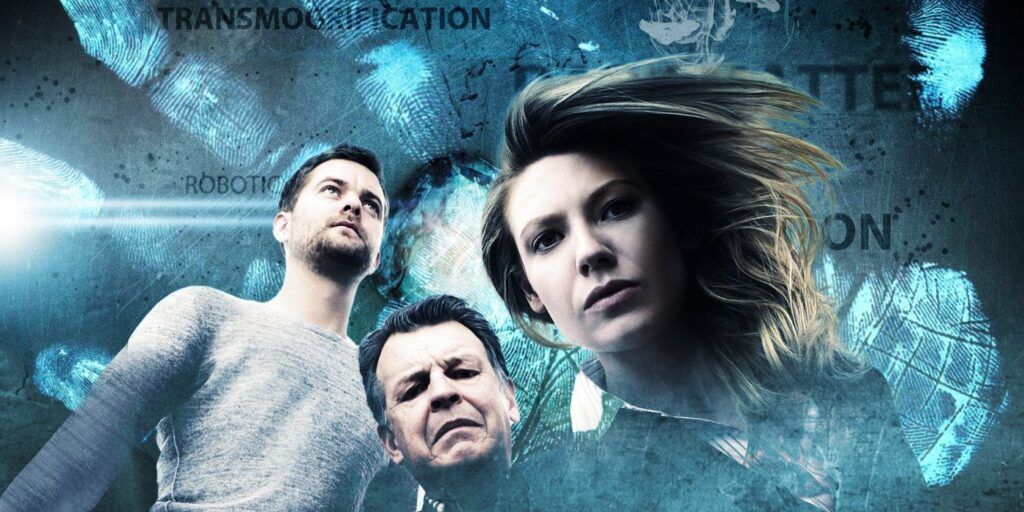Often compared to The X-Files, there was a big difference with how Fringe became a cult classic with its own sci-fi identity. The former exploded into pop culture popularity of the 1990s, with an original run of nine seasons and two Hollywood blockbusters theatrically released. Fringe was the little engine that could, with only five seasons under its belt, the show was constantly on the edge of being canceled, and survived long enough to end on its own terms.
Still, it’s almost a little too easy to compare the two. Both had eccentric characters, “monster-of-the-week” episodes, and science fiction scenarios that got modernized, both even aired on Fox. The premise alone could prove difficult to differentiate the two: an FBI special unit is formed to take on cases unexplainable to the average investigator. But there is a clear difference. The X-Files drew its influence and storytelling heavily from shady government cover-ups of the past. Combining the UFO conspiracy theories of Roswell and paranoia in the presidential scandal of Watergate, the days of blindly trusting in the American government were long gone and The X-Files seized its moment.
By the time audiences could tune in to agents Fox Mulder (David Duchovny) and Dana Scully (Gillian Anderson), it wasn’t considered unpatriotic but wise to be suspicious of the American government, recognizing the public had been lied to far too many times. In 2008, six years after Mulder and Scully left TV, Fringe arrived and looked to the future. Because of that, even though it ended in 2013, Fringe has stayed relevant by predating contemporary concerns and anxieties.
Fringe followed a trio made up of Agent Olivia Dunham (), consultant Peter Bishop (), and his father, mad scientist Dr. Walter Bishop (). Filling up the rest of the main players was Agent Astrid Farnsworth () and the man in charge, Special Agent Phillip Broyles (). Of course, the team wouldn’t be nearly as complete if an additional member was left out — one big diary cow named Gene who lived in Walter’s rustic lab.
All of these characters played an important role in Fringe Division, an FBI unit that looked into solving strange scientific-based incidents. They would also go on to conceptualize the show’s main theme of “family.” Contrasting this sweet-if-oddball family unit were the grisly cases they investigated. Right off the bat, the pilot episode doesn’t hold back. A plane lands thanks to a state-of-the-art autopilot device, but there is no clapping for the efficient and safe touch down. All aboard are dead, from the passengers, flight attendants, to the pilots. Everyone has been infected by a contagion that dissolved their flesh, leaving behind sticky, gooey skeletons.
A key passenger on this mortuary plane, along with the perfected autopilot, are two clues that led Olivia to the international corporation, Massive Dynamic. During the first interaction with the FBI agent, CEO Nina Sharp () reveals the company’s name brazenly acknowledged its grand scale, admitting additionally it’s not possible for the corporation to control everything. But even though Sharp’s motivations are not quite known early on, it’s the company’s founder William Bell () who is even more of an enigma. Is he a good guy or a bad guy? This question propels the first season, as the brave new world that Fringe Division finds themselves up against continues to have connections leading back to Massive Dynamic. The rise of Big Tech was happening back in 2008 but by current standards, the show seems to warn us that there should be uncertainty on such “dynamic” companies increasing its “massive” reach.
Recently, Facebook got tangled up in a scandal by a whistleblower who detailed how the social media platform allowed misinformation to be passed along its followers, not helping a turbulent political landscape. Facebook changed its name to Meta in a small effort to clean up its image and include Instagram and WhatsApp among its properties, Meta has truly provided a digital social network, with additional worries over how much privacy is given to users. Of the other Big Five companies where Meta sits with Google, Microsoft, and Apple, there is Amazon which has successfully made online retail a common way of life. Although Amazon isn’t entirely to blame, shopping malls and department stores have struggled to compete with such precise online presence, thus cutting off much-needed jobs.
Similar in size to Massive Dynamic, there was a photo that circulated online in September 2021 of a colossal Amazon distribution center built in Tijuana, Mexico. The building was surrounded by shacks for local workers that appeared haphazardly structured. In July 2021, space became the new frontier for Amazon, not even Fringe’s conglomerate empire got their hands up in the cosmos. A new space race was commenced, though instead of global governments, it involved billionaires who could throw all the cash needed at the project to rocket up out of the atmosphere. The flights were long enough to reach zero-gravity before descending back down.
With the Blue Origin launch, Amazon and its ex-CEO Jeff Bezos seemed to hint towards future plans in capitalizing on the successful flight, although it’s a little too early to know if Amazon Prime members will get first dibs on those tickets. At the very least, William Bell was only a fictitious character but Bell and Massive Dynamic was just one concern on Fringe. After a science experiment gone wrong, body horror transformed into a hideous mess of a monster in The Fly. An alien life form killed and shape-shifted into the paranoid men stationed at an Antarctica facility in The Thing. Body horror is no different in Fringe, transforming and deforming innocent civilians who were made into guinea pigs by rogue scientists and bio-terrorists. The body of nearly anyone was vulnerable to being weaponized.
A “Fringe case-of-the-week” ran the gamut when it came to beloved sci-fi elements, from psychic abilities to teleportation. Then there were the more bizarre cases, wherein one episode a giant, spiky slug ruptures out of a professor’s body like a Xenomorph, revealed later on to be a super-sized version of the common cold virus. The bizarre was where the show indulged in. From the series’ namesake, fringe science is best defined as theories that include highly speculative and far-fetched ideas.
For the first season, the attacks belonged to a conspiracy (possibly a callback to The X-Files) with Broyles telling Olivia early on, “They’re calling these events The Pattern, as if someone out there is experimenting only the whole world is their lab.” But, from the second season to its last, Fringe shifted away from a simple conspiracy of a single agenda but still kept its rogue scientists and bio-terrorists. In 2022, almost ten years since the show left TV, real-world science has only gotten more frightening, if not always confusing.
The most Fringe-like incident in current events would be the Havana Syndrome, where a sonic weapon was believed to have caused unexplained medical symptoms consisting of headaches and dizziness. In both the U.S. and other countries starting with Cuba, U.S. government officials were afflicted by this mysterious issue. But medical experts don’t all agree it’s a real thing, with some considering the incidents to be mass hysteria. The CIA got involved in investigating the cases but have seemingly concluded foreign enemies are “unlikely” the cause, with no other concrete answer given. A far more extreme sonic weapon was featured in “The Box,” a third season episode of Fringe, where it was one piece of a much bigger doomsday device.
Upon first glance, it looked innocent enough. However, upon opening the metallic box, terribly powerful sonic waves were emitted causing instant bloody, catatonic states to those nearby. And the aforementioned doomsday device isn’t a one-episode-and-done deal. It ties into a major plot line involving a parallel universe that helped Fringe develop a rich and beloved mythology. By its third season, with doppelgängers coexisting alongside Fringe’s prime universe, the show truly escaped the shadow of The X-Files. In this parallel universe, the world is literally coming apart and there is a very real threat of it happening to the prime universe as well. Like peeking into a history book that was never written yet, the show’s writers gave audiences a world succumbing to chaos that would become a reality under different circumstances.
The COVID-19 pandemic acted as a global disruptor and has continued to claim lives. Since the vaccine rollout and safety mandates were set, anxieties have persisted that the vaccine could do more harm than good, leading to a public divide. But what started out as a fear of the swiftly developed vaccine, has since converted medical science into a political agenda.
Then there was the increase of natural disasters scientists have said would be more extreme due to climate change. In August 2021, Europe had terrible flooding from torrential rain and in Germany alone there was unprecedented damage with high fatalities. In December of the same year, the U.S. was affected by a tornado outbreak that tore through Kentucky, ending up even more catastrophic due to it happening at night. With just these two severe weather events, it occurred during seasons or locations not used to the level of damage, and it would seem the decade of 2020 has signaled a new normal.
But if Fringe could be placed under one of Walter’s microscopes with Gene mooing in the background, a crucial piece of the show’s DNA involved the importance of hope. Even with it’s end-of-world scenarios and episodic body horror, it was never bleak. If The X-Files wanted to concentrate on conspiracy theories in distrusting the government. Fringe used its sci-fi concepts to caution but never conclude on worries related to big tech and science. Despite fast-growing technological and scientific achievements, there are pitfalls. Fringe warned that those who have the power to implement it are still only human.
Chris Sasaguay
(35 Articles Published)
Chris Sasaguay is a Horror Features Writer for Collider. His passion in all the dark thrills of scary movies is thanks to a spooky childhood. Growing up, he visited family who lived in the Headless Horseman territory of Sleepy Hollow. Furthermore, if he should ever meet the iconic Jamie Lee Curtis, he’ll swiftly update his profile pic with the encounter. Stay tuned.
More
From Chris Sasaguay
Chris Sasaguay is a Horror Features Writer for Collider. His passion in all the dark thrills of scary movies is thanks to a spooky childhood. Growing up, he visited family who lived in the Headless Horseman territory of Sleepy Hollow. Furthermore, if he should ever meet the iconic Jamie Lee Curtis, he’ll swiftly update his profile pic with the encounter. Stay tuned.
This content was originally published here.




